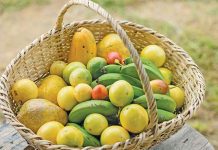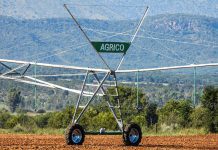This article titled “Horns and Polls in Merinos” by John Stretton appeared in the February addition of the Merino SA Journal. Until 1988, the constitution of the Merino Breeders’ Society restricted the breeding of polled Merinos, which impacted the genetic potential of the type. John unpacks some facts.
Polled, or the absence of horns, is a naturally occurring characteristic of some sheep, cattle and goats and although it has no direct economic importance, it has always aroused the interest of livestock breeders.
Horn growth, like the presence of black wool in fleece, is governed by single genes. However, unlike the natural polled phenomenon in cattle, which is governed by two genes, the presence or absence of horns in sheep, and Merinos in particular, is governed by three genes. These are: P – the poll gene which is dominant to the other two; p’ – the ewe-horn gene which produces true horns (not scurs) in both rams and ewes. It’s recessive to the poll gene but dominant to the third gene, the ram-horn gene; p – the ram-horn gene. This produces true horns in rams only and scurs or knobs in ewes. This gene is recessive to the other two. T here are five variations of horn growth in Merinos. Although knobs or scurs may sometimes be found in depressions, for simplicity sake, the five types are as follows: Poll – a depression or hollow in the skull at the horn site; knob – a hard bony lump at the horn site which may have a horny cap, generally less than 12mm in length; scur – a horny growth which does not have the shape or size of a true horn; small horn – horn growth in some half-poll rams, which have true horn characteristics but which are shorter and thinner than true horns; true horns – robust, curled horns in rams and smaller curled horns in ewes.
As each sheep has its chromosomes in pairs, only two of the three genes can occur in any particular sheep and as there are three genes governing horn growth, there can only be six possible combinations of pairs. These combinations are illustrated in Table 1. nimals carrying only one poll gene (P) are known as half-polls, and rams with short or small horns (Pp) are not culls, as the poll gene is not linked to any other characteristic, good or bad. S mall horns in rams are therefore not a sign of a feminine head, but show that the ram is carrying one poll gene (P). he horn growth in wethers is almost identical to that of ewes, provided they are castrated early. Later castration leads to increased horn growth due to the affect of the male hormone testosterone. It is sometimes claimed that some individual poll rams throw more polled progeny than others, but the results are entirely due to chance. All the progeny of a full poll ram (PP) would of course have at least one poll gene (P), no matter what ewes he is mated to. popular topic of discussion is the origin of the poll Merino and it’s sometimes said that these hornless sheep are the results of “sports”.
A sport is the common word for a mutation, a change in a gene that can be caused for instance by radiation. Genes however are very stable and a natural mutation occurs maybe once in 100 000 sheep. That means a stud producing 2 000 rams/year might see a sport (and it need not be hornless) once every 50 years. It’s too seldom to be of any consequence. It’s certain that there have always been a small proportion of ewes with depressions at the horn site. An occurrence of probably about 1%. These ewes may have either one or both poll genes and go unnoticed as no-one normally examines the horn site at classing time.
In Australia it was found that the occurrence of ewes with depressions was just as prevalent in fine-wool studs as in medium and strong-wool studs. This rules out the source of the poll gene being the result of some previous crossing with British mutton breeds. Limiting the poll line It’s interesting to note that ewes with horns are very seldom found in Australian studs as they are regarded as culls. It’s not certain why they are considered such, while in South-Africa this is not the case. The main advantage of a Merino without horns is that rams are not susceptible to poll strike (maggots behind the horns), which can cause temporary infertility. Other advantages of poll Merinos are that they are easier to shear because they have no horns to get caught in the horns of other sheep or in fences, and they are easier to handle as they don’t cause injury or tear clothing. There are however some advantages to horns on Merinos. Rams are easier to see in a flock of ewes, which is particularly useful when rams get to the ewes at the wrong time of the year. Horns also serve as useful “handles” to hold the sheep by. As the poll gene is in no way correlated to any other characteristic, polled Merinos can be considered no better or worse than horned Merinos.
That polled Merinos don’t generally have the production ability (fleece weight or body weight) of horned Merinos, is simply due to the fact that there are fewer polled Merinos around, which limits the potential for improvement. Until 1988 the constitution of the Merino Breeders’ Society of South Africa placed certain restrictions on members regarding the mating of polled and horned Merinos in registered studs. To be able to breed poll Merinos, a breeder had to register a separate poll stud and no horned rams were allowed to be used in poll studs (which would have improved fleece weights and body weights). Any poll rams born into horned studs were not allowed to be transferred to poll studs and so were considered as culls in horned studs.
Polled and horned Merinos were almost regarded as a separate breeds. As a result of an amendment to both the constitution and bylaws of the society, at the AGM of 1988, these restrictions were lifted. It was then no longer necessary to register a separate poll stud and breeders were free to mate polls to horns and vice-versa. From that time on, polled and horned rams could be entered in the same teams at official sales and could be entered in the same strings at shows. Only one show class remains, “The Best Polled Ram on the Show”. To qualify for the class a ram may not have a knob or scur longer than 30mm. Breeding the poll line It’s interesting to note that all attempts to dehorn Merinos, both in Australia and other countries, have failed. No matter what method, the horn growth is found to be remarkably persistent. Breeding is therefore the only way to have polled sheep, perhaps a blessing in disguise as it means dehorned sheep can’t be passed off as being polled.
The most effective way to increase the number of poll sheep in any flock is to mate the poll rams to horned ewes and the horned rams to poll ewes. In effect this would spread the poll gene around among as many sheep as possible. And it would enable the breeder to select for economically important traits, regardless of whether the sheep is polled or horned and at the same time increase the occurrence of the poll gene in his flock. As we look back after nearly 20 years since the society lifted the restrictions, we see that polled Merinos are far more numerous now than ever before. It’s interesting to note that all sheep breeds that compete with the Merino are polled, while in cattle the trend is definitely away from horns. Who knows, maybe the South-African Merino of the future will be polled. Contact the Merino Breeders’ Society on (049) 892 4148 or e-mail [email protected]. |fw








